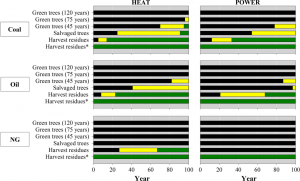 Trees are renewable, so why not let them count under the proposed revisions to the EU renewable energy target? Here we answer this and other questions to demonstrate why burning trees for energy is not inherently climate-friendly.
Trees are renewable, so why not let them count under the proposed revisions to the EU renewable energy target? Here we answer this and other questions to demonstrate why burning trees for energy is not inherently climate-friendly.
What is the EU renewable energy target and its relevance to trees?
The European Union (EU) Renewable Energy Directive establishes an overall policy for advancing the use of energy from renewable sources in the EU. The current framework requires the EU to meet at least 20 percent of its total energy needs with renewables by 2020. Wood is currently the largest contributor to this renewable energy target, accounting for as much as 45 percent of all renewable energy consumed. Much of the forest biomass currently used consists of industrial and harvest residues and traditional fuelwood. However, these sources are nearing full exploitation and further demand for wood for bioenergy will likely come from additional tree harvesting. Even now, Europe is importing wood pellets from U.S. and Canadian forests. Proposals currently under discussion by the European Parliament for a revised Renewable Energy Directive would increase the share of renewable energy in the EU’s total energy mix from 20 percent to at least 27 percent, and possibly 30–35 percent, by 2030. This proposal would likely increase demand to turn trees into energy as EU countries seek ways to meet these more ambitious renewable energy targets.
Originally published on the WRI website.




